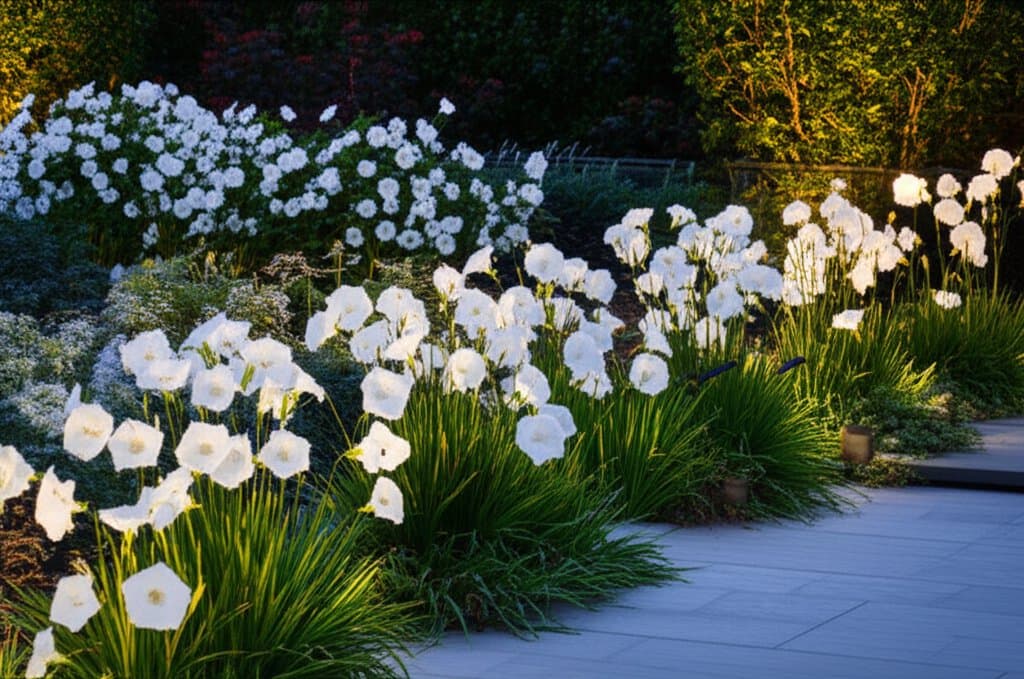Introduction to Night Gardens
Night gardens offer a magical escape as darkness envelops the landscape. These spaces rely on plants that open their petals under moonlight, releasing scents that invite relaxation. By integrating natural glows with subtle design choices, homeowners create intimate areas for evening gatherings or quiet reflection.
The appeal lies in transforming ordinary yards into sensory experiences. Pale blooms reflect available light, while layered textures add depth. This approach not only beautifies the outdoors but also promotes biodiversity by attracting nocturnal pollinators like moths.
Selecting Night-Blooming Plants
Choose plants that thrive in low-light conditions and provide visual and olfactory interest. Focus on species with white or light-colored flowers, as these stand out against the night sky. Consider growth habits, such as climbers for fences or perennials for borders, to suit your garden layout.
Key Night-Blooming Varieties
-
Moonflower (Ipomoea alba): This vine produces large, trumpet-shaped white flowers that unfurl at dusk. The blooms emit a sweet fragrance and can reach six inches across, climbing trellises up to 15 feet. Plant in full sun during the day for optimal evening displays; seeds germinate quickly in warm soil.
-
Evening Primrose (Oenothera biennis): Delicate yellow flowers open in the late afternoon and persist through the night. These biennials self-seed readily, forming colonies that glow softly. They prefer well-drained soil and tolerate partial shade, making them ideal for naturalistic edges.
-
Night-Blooming Jasmine (Cestrum nocturnum): Clusters of tiny white flowers release an intense, tropical scent after sunset. This shrub grows to eight feet and benefits from pruning to maintain shape. Position it near seating areas to maximize the perfume's reach.
-
Tuberose (Polianthes tuberosa): Spikes of creamy white blooms carry a rich, heady aroma reminiscent of lilies. Plant bulbs in spring for summer flowering; they require fertile, moist soil and full sun. Harvest stems for indoor vases to extend the garden's influence.
-
Angel's Trumpet (Brugmansia spp.): Pendulous, trumpet-like flowers in pale shades dangle from branches, perfuming the air deeply. These fast-growing shrubs reach 10 feet and need protection from frost. Use them as focal points in sheltered corners.
Incorporate a mix of annuals, perennials, and shrubs for year-round interest. Test soil pH, aiming for neutral to slightly acidic levels, and amend with compost to support root development.
Designing for Moonlight Illumination
Effective night garden design emphasizes visibility and atmosphere without overwhelming the natural darkness. Start with a layout that guides movement through winding paths lined with reflective gravel or pale stones. These surfaces bounce moonlight, highlighting plant forms.
Layered Lighting Strategies
Natural light sources take precedence, but subtle additions enhance the glow.
-
Install solar-powered path lights along walkways. These low-voltage fixtures activate at dusk, casting soft pools of illumination without harsh glare.
-
Hang string lights from pergolas or trees. Opt for warm white bulbs spaced 12 inches apart to mimic fireflies and frame seating zones.
-
Place lanterns on pedestals near key plants. Battery-operated models with frosted glass diffuse light evenly, accentuating flower textures.
Avoid bright spotlights, as they disrupt the serene mood. Instead, use mirrors or white-painted walls to amplify ambient light from the moon and stars.
Incorporating Sensory Elements
A truly captivating night garden engages all senses. Beyond sight, focus on sound and scent to create immersion.
Fragrances from night-bloomers like jasmine and tuberose waft gently, drawing visitors deeper into the space. Plant in drifts rather than singles to build scent layers; position stronger varieties downwind from entrances.
For auditory appeal, add water features such as bubbling fountains or shallow ponds. The trickle of water soothes and masks urban noise, while attracting frogs that contribute natural choruses. Wind chimes tuned to soft tones, suspended from branches, add subtle melody on breezy evenings.
Textures play a role too. Combine soft grasses with rough bark and smooth leaves for tactile variety. Gravel paths provide crunch underfoot, enhancing the exploratory feel.
Practical Steps for Implementation
Begin by mapping your garden's evening light patterns. Observe how shadows fall and identify sunny spots for day-loving night bloomers. Sketch a plan dividing the area into zones: a central relaxation nook, perimeter plantings, and transitional paths.
Planting and Maintenance Guide
-
Prepare the soil in early spring. Till to a depth of 12 inches, incorporating organic matter to improve drainage and fertility.
-
Space plants according to mature size. For vines like moonflower, provide sturdy supports; shrubs such as jasmine need room for air circulation to prevent disease.
-
Water deeply but infrequently. Night gardens often require less irrigation once established, as cooler evenings reduce evaporation. Mulch around bases to retain moisture and suppress weeds.
-
Fertilize sparingly with a balanced, slow-release formula in spring. Overfeeding leads to lush foliage at the expense of flowers.
Monitor for pests like aphids, which target tender night bloomers. Use insecticidal soap sprays applied at dawn to avoid harming beneficial nocturnal visitors.
Seasonal care includes winter protection for tender perennials. Cover with frost cloth or move potted specimens indoors. In mild climates, evergreens like some jasmine varieties provide winter structure.
Extending Your Night Garden's Reach
Integrate the space with your home by installing outdoor speakers for soft music or placing weatherproof furniture in the glow. Host evening dinners under the stars, with the garden as a living backdrop.
These designs not only elevate aesthetics but also foster well-being. Studies show that time in natural settings reduces stress, and night gardens amplify this effect through tranquility. Invest in this project to reclaim evenings, turning your yard into a personal oasis that blooms long after sunset.

